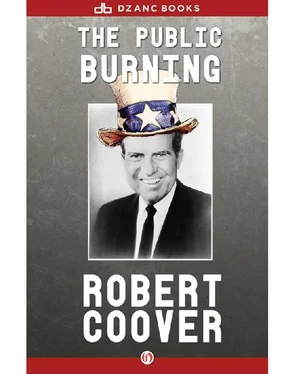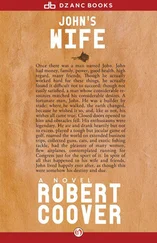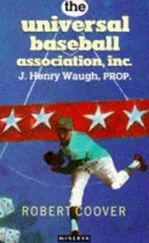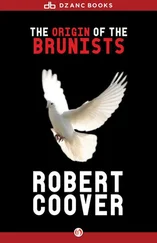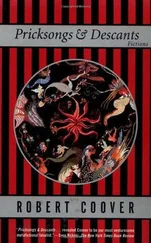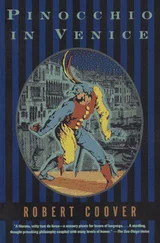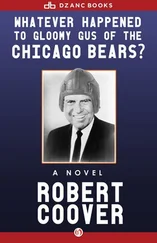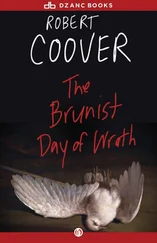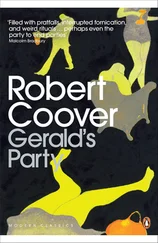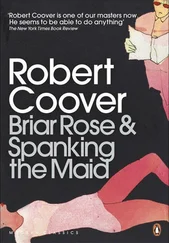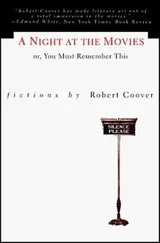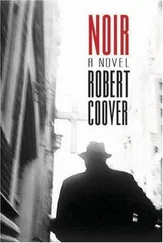On his way, Uncle Sam stops off in Times Square to inspect the cleanup operations and reconstruction of the Death House set, finds the electricians despondent over the condition of the electric chair, uprooted and half-wrecked, lying in the gutter, draped with the broken Uncle Sam manikin with its Hitler moustache. Workmen are painting over a sign on the south face of the Hotel Claridge that says THE TRADITION OF ALL PAST GENERATIONS WEIGHS LIKE A NIGHTMARE UPON THE BRAIN OF THE LIVING. Uncle Sam strips the manikin of its wig, Uncle Sam suit, and moustache, and what he discovers under all that is not a replica of himself — that stern puritanical visage and lithe powerful frame — but a figure that looks like a cross between Bishop Fulton Sheen, Everett Dirksen, and Our Miss Brooks, and as sexless as Christine Jorgensen. Just a little lump down there, a shiny bulge, like a tumor, and smooth as Ike’s bald pate. Uncle Sam turns it over his knee as though to spank it, but actually to inscribe on it Henry Adams’s dictum: “Modern politics is, at bottom, a struggle not of men but of forces,” and he orders that the manikin, what’s left of it, be hung from the nearest flagpole as a kind of old-time Broadway parable on the nature of reality and illusion.
More of a problem is what to do about the electric chair: it’s really in bad shape. Wiring all ripped out, legs busted, bolts threaded, leather straps shredded, electrodes swiped. The auxiliary generator has been taken apart and the pieces carried off: nothing left but the concrete base and a protective wire fence. The rheostats and voltmeters are gone, too, and up on the stage, somebody has taken a sledgehammer to the switch panel. Warden Denno, Cecil B. De Mille, Executioner Francel, Electric Charlie Wilson, Rube Goldberg, and others gathered in the Square to put things back together again, are deeply distressed. These electric chairs are relatively rare, no chance to get a new one made this late in the game, and this one seems clearly beyond repair—
But not so! They watch, astounded, as with one fluid movement, Uncle Sam lifts from the gutter the wrecked chair, light as a matchbox for him, squeezes the splintered wood whole again, and bolts it down on the concrete part of the stage with hammer blows of his powerful fists! Wow! A commanding figure, Uncle Sam; crowds have gathered in the Square to ogle him, root for him, worship him even, discovering in their Superhero all that’s best in themselves. He now studies, tugging thoughtfully on his white goatee, the ripped-out wiring and sabotaged switch, and one is reminded of Tom Jefferson, rugged and tall, poring over his designs for the White House or struggling with his quirky polygraph machine, or perhaps of Handsome Frank Pierce, puzzling over the metaphysical obscurities in the books of his friend Nat Hawthorne. Just as, yesterday, as he fought back against the Phantom’s reckless spree, one saw glimpses of Old Hickory galloping up on Horseshoe Bend, T. R. throwing steers in the Badlands, Abe Lincoln splitting rails, or as now one seems to see George Washington crossing the Delaware or Franklin Roosevelt projecting the Four Freedoms in the simple way in which Uncle Sam instructs the workmen on the repair of the electrical system and sends them off to get the parts they need from Pitt Machine Products Company Incorporated, over by the synagogue on East Houston Street.
“You mean, we just take the stuff, or…?”
He hands them the key, looking like Ulysses Grant handing his manuscript over to his publishers. “It’s already took,” he says quietly, his voice firm and gentle as Silent Cal’s. “That business used to belong to Julius Rosenberg.”
There is this peculiar quality about Uncle Sam: it’s as though his many metamorphoses since his early days as an Inspector of Government Provisions have each left, mysteriously, their mark on him. One discovers Old Tip Harrison’s long nose in the middle of his face, little Jemmy Madison’s scraggly white hair (or is it Old Zack’s or Little Van’s? certainly he’s got Zack Taylor’s craggy cheeks and rough-and-ready ways), Willie (Big Lub) Taft’s gold watchchain, old Jim Monroe’s bony rump still in its — even then — out-of-date pantaloons. Debilities have been shed, donated to museums, or else never assumed (just part of the real-time cover story) — Washington’s rhinoceros teeth and smallpox scars, F.D.R.’s shriveled legs, Cleveland’s vulcanized rubber jaw, Abe’s warts and Jim Polk’s spastic bowels — but virtues and marvels have been laid on, fortified and refortified, many times over: there’s the lean virility of Monroe, Jackson, and “Stud” Tyler, steadily augmented by passage through the likes of Long Abe, Doc Wilson, and Ike; there’s that willful hard-set jaw, shaped by every Incarnation from “54–40 or Fight” Polk to Reverend Garfield, Ugly Honest Grover Cleveland, and the Roosevelt boys, not to mention the strange subtle influences of such as Hamilton and Burr, Clay and Calhoun, Bill Borah, Harry Hopkins, and even Ed Stettinius; there’s the lofty pride of John (His Rotundity) Adams, the shrewdness of the Red Fox of Kinderhook, the Grecian mouth of Millard Fillmore, and a hand calloused by the campaign habits of everyone from Matty Van Buren and Chet Arthur, the Gentleman Boss, to affable Warren Harding, who once shook hands with 6756 people in five hours. When he cocks his head a certain poll-parrot way, he recalls Old Buck Buchanan, who had one nearsighted eye and one farsighted eye — which alone was enough to qualify him as Uncle Sam’s Incarnation. And when, as now, tracing leads, fusing wires, unbending panels, putting this electrical system back together again, he scowls in concentration through a pair of antique wire-rimmed spectacles perched halfway down his Yankee nose, one cannot help but remember Citizen Ben Franklin jotting down his scientifical notes by candlelight after successfully sucking electrical fluid down a kite string. Or the old Rough Rider himself, Teddy Roosevelt, squinting to hide his lame left eye. Abe Lincoln trying to read the program in the weak light of Ford’s Theater: “Other means may succeed,” Uncle Sam says, glancing up at these recognitions, sparks flying between his fingers, “this cannot fail!” Fsst! Sizzle! POP! “As America’s greatest Prophet once said, ‘There is always a best way of doin’ everything…’” The marquee lights dip, there’s a crackling hum on-stage and a faint glow: it is done, the chair is ready! “‘… Even if it be to bile an egg!’”
Huzzahs from the crowd, beaming smiles from the gathered functionaries, who try to get as close to Uncle Sam as possible. The workmen line up and sing “Hail to the Chief,” then test out the chair by burning six or seven chimpanzees in it. And high over the Square behind Father Duffy, up where the Chevy sign used to be: the headlines from the Newton Kansan of exactly eighty years ago today, June the 19th, 1873:
LET PATRIOTS EVERYWHERE PREPARE TO DO THE CLEAN THING
BY UNCLE SAM AND HIS BALDHEADED EAGLE!
9. The Vice President’s Beard
Shaving that morning, I thought: I was born a hundred years too late. If I could let this damn thing grow, I’d look like Ulysses S. Grant. There’d be no more talk about shyster corporation lawyers and used-car salesmen then. I could say what I pleased, glowering over my beard, and everybody would listen. Black and bushy, like Saint Peter or Henry VIII or Whit What’s-his-name. Walt Whitman. My skinned nose and forehead gave me a special ferocity this morning. I growled at myself in the bathroom mirror: G-r-r-row-w-f-f! Beauty and the Beast, that game I used to play with Pat before we were married, my secret self. She thought it was funny, she didn’t understand. Mess up my hair, roll my eyes, shake my jowls, the good old days. I could always get a laugh then. If I’d worked at it, I might have been another Jack Benny.
Читать дальше
